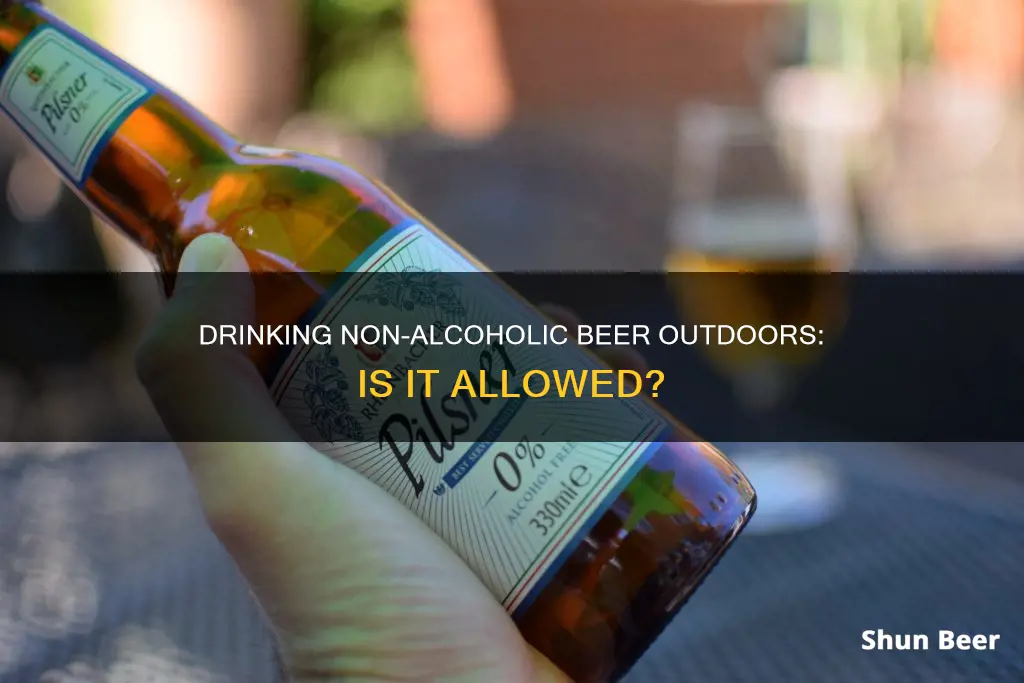
Drinking non-alcoholic beer outside is a topic that covers a wide range of issues, from social customs and laws to health considerations. Social norms and legal restrictions surrounding alcohol consumption in public spaces vary significantly across the world, with some countries having more permissive attitudes than others. In terms of health, non-alcoholic beer is often marketed as a safer alternative to regular beer, but it's important to note that it may still contain small amounts of alcohol, posing risks for certain individuals. Additionally, the taste and flavour of non-alcoholic beer are common points of discussion, with some people preferring it as a bitter, carbonated drink option.
| Characteristics | Values |
|---|---|
| Legality of drinking non-alcoholic beer outside | Varies by country and state |
| Legality of drinking non-alcoholic beer while driving | Varies by country and state |
| Health concerns | Non-alcoholic beer may still contain alcohol, and may be dangerous for those with alcohol use problems and pregnant people |
What You'll Learn

Drinking non-alcoholic beer while driving
From the outside, it is difficult to distinguish non-alcoholic beer from regular beer, and law enforcement officers may suspect you of drinking and driving. If you are pulled over, once the officer realizes it is a non-alcoholic drink and you have not consumed anything else, you will likely be allowed to continue driving. However, it is important to note that some non-alcoholic beers may contain a higher percentage of alcohol, and consuming a large amount can affect your motor skills and lead to a failed breathalyzer test.
The laws regarding the consumption of non-alcoholic beer while driving vary from place to place. In some areas, any detectable level of alcohol in a driver's system can have legal consequences. For example, in zero-tolerance states in the US, having any amount of alcohol while driving can result in legal ramifications. Similarly, in Ontario, Canada, if you are below 25, any registration of alcohol on a breathalyzer, regardless of the amount, can lead to a suspended license. Thus, it is crucial to be aware of the local laws and regulations to avoid legal complications.
While non-alcoholic beer is generally considered a safer alternative to alcoholic beverages, drinking any type of beer while driving can lead to a sense of complacency or distraction. Additionally, the perception of drinking and driving, even with non-alcoholic drinks, carries significant stigmas and potential safety risks. Therefore, it is essential to understand the implications and responsibilities of consuming non-alcoholic beer while driving and to prioritize safety at all times.
Beer and Birth Control: Is It Safe to Mix?
You may want to see also

Drinking non-alcoholic beer in public
In the UK, for example, public drinking is generally accepted, and there are no specific laws prohibiting it. However, local ordinances in certain cities, such as Antwerp and Brussels in Belgium, may restrict public alcohol consumption in specific areas.
In countries like Norway, Poland, India, and Sri Lanka, as well as some US states and Muslim-majority countries, public drinking is largely condemned or illegal. On the other hand, countries like Denmark, Portugal, Spain, Germany, the UK, New Zealand, Japan, Finland, and China accept and legalise it.
It is important to note that even in places where public drinking is allowed, there may be restrictions on drinking in certain public areas, such as near schools or parks, or during specific times. Additionally, public drunkenness and related behaviours like rowdiness or violence may be prohibited and punished, even in places where drinking itself is permitted.
When considering drinking non-alcoholic beer in public, it is crucial to be aware of the local laws and social norms of the specific location. While non-alcoholic beer typically contains very low or no alcohol, it may still be restricted in certain places due to its resemblance to regular beer in terms of taste and packaging. Checking the alcohol content and local regulations before consuming non-alcoholic beer in public is always advisable.
Mixing Beer and Adderall: What You Need to Know
You may want to see also

The health implications of non-alcoholic beer
Non-alcoholic beer is often marketed as a healthier alternative to regular beer, and in many ways, it is. Non-alcoholic beers typically have fewer calories, contribute to better sleep, and can even help with post-exercise recovery. However, it's important to be aware of the potential risks associated with non-alcoholic beer, especially for certain individuals.
The Benefits
Non-alcoholic beer has several potential health benefits. Firstly, it promotes post-exercise recovery by providing fluids and carbohydrates to help the body recuperate after strenuous activity. It also rehydrates the body more effectively than alcoholic beer, as it doesn't have a diuretic effect, which can lead to dehydration.
Additionally, non-alcoholic beer may improve cardiovascular health by reducing blood pressure, inflammation, and homocysteine levels. It may also increase antioxidants in breast milk, reduce the risk of osteoporosis, and improve copper metabolism, which is important for joint health and anaemia prevention. The hops in non-alcoholic beer contain compounds that promote better sleep and reduce anxiety and stress.
The Risks
Despite these benefits, non-alcoholic beer does come with certain risks. Firstly, it may still contain small amounts of alcohol, which can be dangerous for pregnant individuals. According to the American College of Obstetrics and Gynecology (ACOG), pregnant people should avoid any alcohol consumption to prevent fetal alcohol spectrum disorder (FASD).
Non-alcoholic beer can also pose challenges for those recovering from alcohol use disorder. The smell and taste of non-alcoholic beer may trigger cravings and increase the risk of relapse. Therefore, it is generally recommended that individuals recovering from alcohol addiction avoid non-alcoholic beer and anything that smells like alcohol.
Furthermore, while non-alcoholic beer may have fewer calories than regular beer, it still contains carbohydrates and should be consumed in moderation. It's also important to read labels carefully, as some non-alcoholic beers have been found to contain more alcohol than indicated, and the legal limit for "non-alcoholic" classification varies across regions.
In conclusion, while non-alcoholic beer can be a healthier alternative to regular beer in some ways, it is not without its potential risks. It is always important to consider individual circumstances and make informed choices about beverage consumption.
The Science of Nitro Beers: How Do They Work?
You may want to see also

The legality of non-alcoholic beer for minors
The ambiguity surrounding the legality of non-alcoholic beer for minors stems from the fact that non-alcoholic beverages are still regulated by the Federal Alcohol Administration Act (FAA), even though their alcohol content is below the threshold for what is considered an alcoholic beverage. Additionally, the legal drinking age is not a federal rule but is set by each state, leading to variations in the definition of an alcoholic beverage and the laws surrounding the purchase and consumption of non-alcoholic drinks by minors.
To further complicate matters, the laws in some states allow minors to consume alcoholic beverages under certain conditions, such as when they are under the supervision of a parent, guardian, or spouse who is over the age of 21. This adds another layer of complexity to the legality of non-alcoholic beer for minors, as the definition of an "alcoholic beverage" becomes blurred.
In other countries, the laws surrounding the purchase and consumption of non-alcoholic beer by minors can also vary. For example, in the United Kingdom, beverages containing less than 0.5% ABV are not subject to age restrictions, while in Sweden, beer below or equal to 2.25% ABV can be sold to minors, although some stores voluntarily opt-out of selling it to them.
Overall, the legality of non-alcoholic beer for minors is a complex and nuanced issue that depends on the specific laws and regulations of the country, state, or even county in which the minor is located. It is essential to know and understand the local regulations and retailer policies before attempting to purchase or consume non-alcoholic beverages as a minor.
Drinking Non-Alcoholic Beer: Is It Safe to Drive?
You may want to see also

The process of making non-alcoholic beer
Non-alcoholic beer is a relatively new product in the market, and its popularity is rising rapidly. The main difference between non-alcoholic and alcoholic beers is the alcohol content. Non-alcoholic beers have zero to very little alcohol content (less than 0.5% alcohol by volume).
There are two overarching methods to making non-alcoholic beers. One method is to interfere with the brewing process to prevent the formation of alcohol during fermentation. The other method is to remove alcohol from a fully brewed, alcoholic beer.
Alcohol Reduction and Prevention
No fermentation
No fermentation brewing is done by withholding yeast from the wort and, therefore, eliminating any possible production of alcohol. This is a relatively simple method to execute and will guarantee a 0.00% brew. This approach is common in many Islamic countries, where alcohol, even in trace amounts, is prohibited by law.
Limited or arrested fermentation
This approach works by adjusting the brewing process to limit or prevent fermentation in the beer. Most commonly, brewers prepare the wort to contain fewer fermentable sugars than in a standard recipe. By lowering the level of fermentable sugars, the yeast won't be able to form high amounts of alcohol.
Some brewers will utilise a process called arrested fermentation. During this, yeasts are inactivated or removed before they can start producing alcohol in high amounts. This can be done by ensuring the wort does not get any hotter than 60°F. Alternatively, the fermenting beer can be rapidly cooled to almost freezing temperatures.
Utilisation of special yeast
With the rise in popularity of low and non-alcoholic beer, yeast suppliers have been working hard to research and develop specific yeast strains for non-alcoholic production. Many of these strains cannot ferment certain types of sugars such as maltose. These strains can positively contribute to flavour, such as increased aromas, which are harder to achieve with other methods.
Alcohol Removal
Dealcoholization
Dealcoholization involves removing alcohol from a liquid that contains it. The most common way to do this is by adding water or steam to the liquid and boiling it under pressure. This releases the alcohol as vapour into a condenser, where it is collected and removed. The remaining liquid is then sold as non-alcoholic beer.
Dilution
Dilution involves adding water to the finished, leaded beer, which reduces the alcohol content. The amount of water added will depend on how much alcohol there is in the original brew, but typically it's around 10%.
Simulated fermentation
In some situations, brewers want to avoid the fermentation of sugars altogether. With the simulated fermentation method, they skip the fermentation process when brewing and add ingredients and enzymes to simulate the same effect.
Vacuum distillation
Vacuum distillation lowers alcohol's boiling point, meaning other volatile flavour chemicals are less affected, and the flavour remains closer to the original. Instead of heating the beer to the point where it might lose its flavour, the beer only reaches a fairly warm temperature.
Reverse osmosis
Reverse osmosis is the same process used to desalinate ocean water. Beer is passed through a filter with pores so small that only alcohol and water (and a few volatile acids) can pass through. The alcohol is distilled out of the alcohol-water mix, and the water and remaining acids are then added back into the syrupy mixture of sugars and flavour compounds left on the other side of the filter.
Membrane filtration
Membrane filtration of the beer involves running full-strength beer through a specific membrane that only allows alcohol, colour, and some flavour/aroma compounds through. The result is that the water is removed from the beer, the alcohol is distilled off, and then the water is returned to the beer.
History of non-alcoholic beer
The forebears of modern non-alcoholic beer date back to medieval Europe. These brews were made for everyday consumption by the working classes as a safer substitute for often polluted water, with just enough alcohol present to kill bacteria.
What really kick-started the production of non-alcoholic beers was Prohibition in the US, which began in 1919. During this time, breweries like Anheuser-Busch, Miller, and Schlitz were forced to produce "near beer" that was very pale, not so flavourful, and just 0.5% ABV.
Drinking Beer on Rhode Island's Beaches: What's Allowed?
You may want to see also
Frequently asked questions
It depends on the country and local laws. Some countries and states have laws against public drinking of any kind, while others only prohibit alcoholic beverages.
This depends on the laws of the country or state you are in. In general, it is not recommended as even small amounts of alcohol can impair your ability to drive.
Yes, non-alcoholic beer may still contain small amounts of alcohol, and it is high in carbohydrates and calories. It can also be a trigger for people with alcohol use disorders and should be avoided by pregnant people.
This varies by location. In some places, non-alcoholic beer is treated the same as alcoholic beer and is subject to the same restrictions. In other places, it is legal for minors to consume non-alcoholic beer.
People may choose non-alcoholic beer as a healthier alternative to regular beer, to avoid the effects of alcohol, or for religious reasons.







